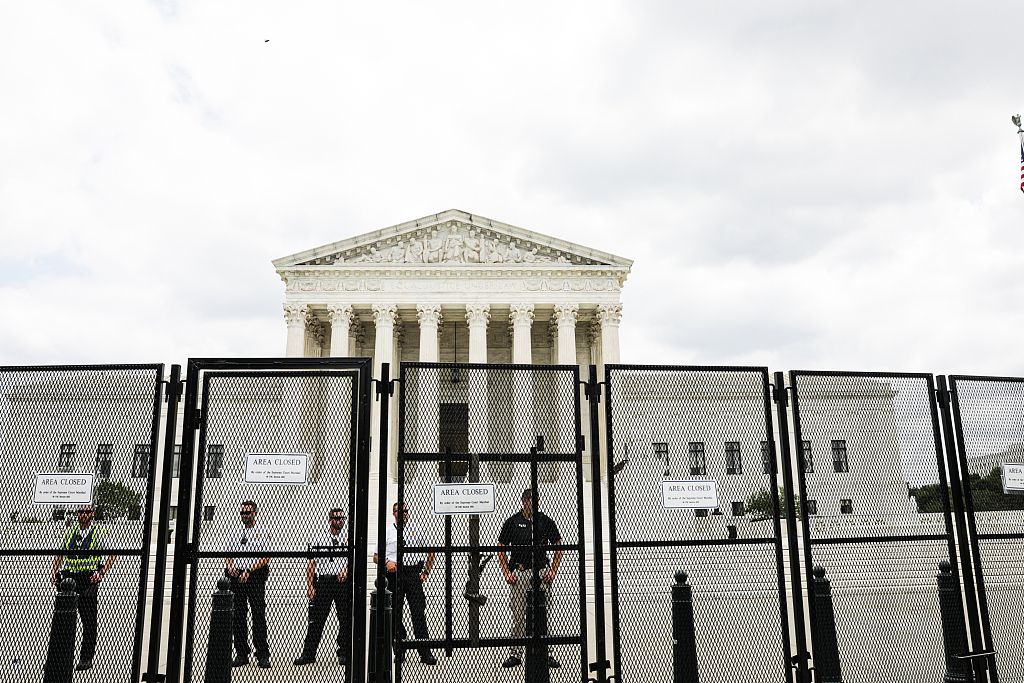The Supreme Court decision to overturn Roe v Wade, the 1973 ruling which made abortion a constitutional right in the United States, has energized both sides of a longstanding part of the U.S. culture wars, potentially with significant electoral consequences.

An "Abortion is Freedom" rally outside the U.S. Supreme Court in Washington, D.C., July 4, 2022. /CFP
An "Abortion is Freedom" rally outside the U.S. Supreme Court in Washington, D.C., July 4, 2022. /CFP
The decision on June 24 was applauded by some, but ongoing protests are just one sign of the strength of feeling opponents have towards the ruling, which puts abortion rights in the hands of the individual states, several of which have already imposed sweeping restrictions.
How do Americans view the ruling?
Polling conducted since the Supreme Court's ruling indicate that a large majority of Americans disapprove of it and also, ahead of critical midterm elections scheduled for November, that Democrats could see some electoral advantage in polls that had looked guaranteed to leave the Republicans in control of both houses of Congress.
In the week after the decision, a slew of polls found similar results. Monmouth University found 60 percent disapprove to 37 who approve, NPR/PBS/Marist put the margin at 56-40 against, and CBS/YouGov at 59-41.

Speaker of the House Nancy Pelosi reacts to the Supreme Court decision overturning Roe v Wade, at the Capitol in Washington, D.C., June 24, 2022. /CFP
Speaker of the House Nancy Pelosi reacts to the Supreme Court decision overturning Roe v Wade, at the Capitol in Washington, D.C., June 24, 2022. /CFP
Two weeks on, polling from Pew Research poll indicated little had changed: 57 percent disapproved to 41 percent who approved. And the numbers were similar before the decision was taken. Around 61 percent believed abortion should be legal in all or most cases before the ruling, per Pew, and that number climbed to 62 percent in the most recent poll.
So while Americans’ general standpoint on abortion has trended increasingly pro-choice since 2010, according to the polling, it has been relatively unchanged by the ruling.
What does the party breakdown reveal?
The polling indicates that the importance voters place on abortion as an electoral issue has changed, however.
In a July 12 survey from Ipsos and FiveThirtyEight, there was a 10 percentage point monthly jump in Americans who see abortion as a major issue, though inflation was comfortably the top concern.

Capitol Police outside the U.S. Supreme Court in Washington, D.C., June 24, 2022, after the 1973 Roe v Wade decision was overturned. /CFP
Capitol Police outside the U.S. Supreme Court in Washington, D.C., June 24, 2022, after the 1973 Roe v Wade decision was overturned. /CFP
There is inevitably a partisan breakdown. Democrats tend to be in favor of more liberal abortion rights, Republicans tend to favor tighter restrictions. However, with the approaching midterms in mind, the intensity of that breakdown could be particularly relevant.
In Ipsos’ July poll, 27 percent of Democrats said abortion was a top issue, up from 13 percent in June. The share of independents who saw abortion as a major issue jumped from 8 percent to 17 percent, and for Republicans the increase was from 8 percent to 13 percent.
That trend, also evident in polls elsewhere, suggests that the Democrats’ attempts to make the issue central to their midterm campaign – with a message that change will only come by voting for their candidates – could be politically helpful to the party, despite their strong opposition to the ruling.
What do key indicators suggest about 2022?
The 2022 midterms feature 435 House races, 34 Senate elections and 36 gubernatorial polls, with different candidates in different states running on different issues.
There are two often-used shortcuts for gauging sentiment in a midterm year.
The first is the president’s popularity sat alongside how people feel the economy is doing. On this score, the Democrats are in serious trouble in November.
Biden’s ratings are dire. According to FiveThirtyEight’s historical aggregate of presidential approval ratings for the first 18 months in office, Biden has the lowest rating on record for recent presidents at 38.6 percent approval.
On the economy, the data is also bleak for Democrats. June’s tracker by the University of Michigan, for example, found consumer sentiment was down a huge 30.3 percentage points since the previous year, “reaching its lowest recorded value, comparable to the trough reached in the middle of the 1980 recession.” The survey found inflation was the biggest driver of negative sentiment followed by gas prices, both issues the administration is struggling to curb.

President Joe Biden speaks before signing an executive order protecting access to reproductive health care services, in the White House, Washington, D.C., July 8, 2022. /CFP
President Joe Biden speaks before signing an executive order protecting access to reproductive health care services, in the White House, Washington, D.C., July 8, 2022. /CFP
A key reason for Biden’s low approval rating is a fall in support from his own party on economic issues. A June survey by Ipsos and ABC found that only 28 percent of Americans approved of Biden’s handling of inflation and 27 percent of his handling of gas prices. Within those headline numbers, only 56 percent of Democrats backed him on inflation and 51 percent on gas prices.
With Biden’s approval and economic confidence low, a key question is whether the attitude toward the president directly transfers to negative sentiment towards the Democrats.
The second midterm prediction shortcut, the generic ballot, gives a clue. It asks which party the respondent would vote today, irrelevant of candidate. This data is brighter for the Democrats, and there are indications of a change since the Supreme Court overturned Roe v Wade.
The RealClearPolitics aggregate of generic ballot polling indicates that the Republicans held a 3.4 percentage point advantage on June 24, when the ruling was made, and that had fallen to 1.9 points by July 13.
Use of the aggregate guards against outliers, but in the past week there has been further encouragement for Democrats in the latest YouGov, Morning Consult and Siena polls, which showed Biden’s party ahead 3, 4 and 1 percentage points respectively.
Has the focus on abortion changed the math?
So has the Supreme Court decision had a significant impact on forecasts for the midterms?
The broad polling data suggests that while the response to the ruling favors the Democrats electorally, the issue of abortion itself is not among the most important to Americans in the current climate of high inflation, gun violence and political extremism. It is perhaps important that both addressing gun violence and opposing political extremism are also stronger electoral issues for Democrats than for Republicans.
With under four months to go until the elections Biden’s party is still fighting an uphill battle to keep control of Congress. The Republicans are strong favorites in the House and the race for the Senate is tight, but current trends suggest issues like abortion being in the news is helping the Democrats in the polls – and that gives Biden’s party hope of a better result in November than looked possible a month ago.

